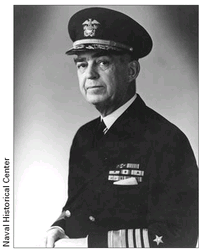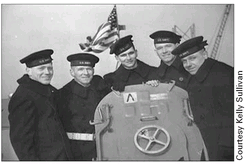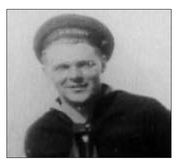War Stories II (38 page)
Authors: Oliver L. North

 NORTHEAST OF SANTA CRUZ ISLAND
NORTHEAST OF SANTA CRUZ ISLANDNEAR 165° LATITUDE, SOUTH PACIFIC
26 OCTOBER 1942
2130 HOURS LOCAL
26 OCTOBER 1942
2130 HOURS LOCAL
A few hours after Mitch Paige and his desperately outnumbered Marines had prevailed in fighting for their lives to hold Bloody Ridge, Admiral Kinkaid and the sailors and airmen of the
Enterprise
and
Hornet
battle groups found themselves engaged in a battle of their ownâwith about the same odds. Admiral Nobutake Kondo had departed Truk with an armada of four aircraft carriers, five battleships, fourteen cruisers, and forty-four destroyers, intending to support General Kawaguchi's ground offensive.
Enterprise
and
Hornet
battle groups found themselves engaged in a battle of their ownâwith about the same odds. Admiral Nobutake Kondo had departed Truk with an armada of four aircraft carriers, five battleships, fourteen cruisers, and forty-four destroyers, intending to support General Kawaguchi's ground offensive.
Â
Admiral Thomas Kinkaid commanded the USS
Enterprise
task force and later commanded MacArthur's 7th Fleet.
Enterprise
task force and later commanded MacArthur's 7th Fleet.

But he arrived too late. At about 0300 on the morning of 26 October, a PBY out of Espiritu Santo detected Kondo's carriers shortly after he had turned north after receiving word that Kawaguchi's ground attack had failed.
Halsey, hearing the patrol plane's report and looking at his plotting board in Noumea, sent a three-word “flash” precedence message to Kinkaid: “ATTACK. REPEATâATTACK.”
At dawn on 26 October, aircraft from the
Enterprise
found Kondo's fleet northeast of the Santa Cruz Islands and promptly holed the flight deck of the light carrier
Zuiho
. But the Japanese counter-attacked immediately, pounding
Hornet
with bombs and torpedoes, leaving the carrier dead in the water, afire and listing.
Enterprise
found Kondo's fleet northeast of the Santa Cruz Islands and promptly holed the flight deck of the light carrier
Zuiho
. But the Japanese counter-attacked immediately, pounding
Hornet
with bombs and torpedoes, leaving the carrier dead in the water, afire and listing.
By midday the Battle of the Santa Cruz Islands was over. U.S. bomb and torpedo attacks had crippled the heavy cruiser
Chikuma
and seriously damaged the carrier
Shokaku
. The American pilots and anti-aircraft gunnersâparticularly those on the battleship
South Dakota
âhad killed 102 of Kondo's airmen. But a Japanese sub managed to slam a torpedo into the side of the destroyer
Porter
, and the final air raid of the engagement had put three bombs into the flight deck of the
Enterprise
.
Chikuma
and seriously damaged the carrier
Shokaku
. The American pilots and anti-aircraft gunnersâparticularly those on the battleship
South Dakota
âhad killed 102 of Kondo's airmen. But a Japanese sub managed to slam a torpedo into the side of the destroyer
Porter
, and the final air raid of the engagement had put three bombs into the flight deck of the
Enterprise
.
The
Porter
had to be scuttled and
Hornet
went down after darkâjoining the remains of seventy-four U.S. Navy pilots who had been downed in the fight. As the
Enterprise
and her escorts limped back to the south as Kondo retired toward Truk, for the first time since the war began, the U.S. Navy had no operational carriers in the Pacific Ocean.
Porter
had to be scuttled and
Hornet
went down after darkâjoining the remains of seventy-four U.S. Navy pilots who had been downed in the fight. As the
Enterprise
and her escorts limped back to the south as Kondo retired toward Truk, for the first time since the war began, the U.S. Navy had no operational carriers in the Pacific Ocean.
 NAVAL BATTLE OF GUADALCANAL
NAVAL BATTLE OF GUADALCANALNEAR GUADALCANAL, SOLOMON ISLANDS
13 NOVEMBER 1942
2330 HOURS LOCAL
13 NOVEMBER 1942
2330 HOURS LOCAL
The stunning Japanese losses ashore on Guadalcanalâroughly ten killed for every American casualtyâdid nothing to diminish Tokyo's insistence that the island be recaptured. By 12 November the Tokyo Express had brought Kawaguchi's ground forces up to nearly 30,000 troopsâmore than the Americans had ashore. The Japanese continued their persistent probes and contact patrols, creating casualties on both sides every day and night. But they never again mounted another major ground offensive against the airfields.
At sea, however, it was a different story. For the remainder of October and up through the first days of November, the Tokyo Express continued an established pattern of nighttime deliveries of troops and suppliesâthen
blasting away with naval guns at the U.S. Marines and Army troops ashoreâbefore scooting back up the slot to safety. But on 5 November, Station Hypo code-breakers deciphered a lengthy message ordering another major attack. Cruisers, carriers, battleships, and eleven transports escorted by an equal number of destroyers were directed to deliver 13,500 fresh Japanese troops to Kawaguchi.
blasting away with naval guns at the U.S. Marines and Army troops ashoreâbefore scooting back up the slot to safety. But on 5 November, Station Hypo code-breakers deciphered a lengthy message ordering another major attack. Cruisers, carriers, battleships, and eleven transports escorted by an equal number of destroyers were directed to deliver 13,500 fresh Japanese troops to Kawaguchi.
After seeing this intelligence, Nimitz called for help. Bombers and fighters were flown out from Hawaii. A regiment of Marines from the 2nd Marine Division and 6,000 more soldiers from the Americal Division recently arrived from the U.S. were rushed to shore up Vandegrift's defenses. Repairs to the
Enterprise
were hastily completed and she was dispatched with the battleships
Washington
and
South Dakota
in company to seek out and destroy the enemy counter-invasion force.
Enterprise
were hastily completed and she was dispatched with the battleships
Washington
and
South Dakota
in company to seek out and destroy the enemy counter-invasion force.
On the afternoon of 12 November, a hastily assembled U.S. cruiserdestroyer force, designated as Task Force 65 and commanded by Rear Admiral Dan Callaghan, took up station at the southern end of the slot to intercept the Japanese Combined Fleet. Task Force 65 consisted of two heavy cruisers: the USS
San Francisco
(Callaghan's flagship, damaged when a Japanese pilot crashed his flaming plane into her) and USS
Portland
; three light cruisers:
Atlanta
(Admiral Scott's flagship),
Helena
, and
Juneau
; and eight destroyers:
Barton
,
Monssen
,
O'Bannon
,
Cushing
,
Laffey
,
Sterett
,
Aaron Ward
, and
Fletcher
âthirteen ships in all. They were no match for the two battleships, heavy cruiser, and fourteen destroyers under the command of Admiral Hiroaki Abe.
San Francisco
(Callaghan's flagship, damaged when a Japanese pilot crashed his flaming plane into her) and USS
Portland
; three light cruisers:
Atlanta
(Admiral Scott's flagship),
Helena
, and
Juneau
; and eight destroyers:
Barton
,
Monssen
,
O'Bannon
,
Cushing
,
Laffey
,
Sterett
,
Aaron Ward
, and
Fletcher
âthirteen ships in all. They were no match for the two battleships, heavy cruiser, and fourteen destroyers under the command of Admiral Hiroaki Abe.
It was clear but moonless at 0200 on 13 November when the two forces met at close range in the waters between Guadalcanal and Savo Island. In a furious thirty-minute melee, which the Marines watched from ashore, both Admirals Callaghan and Scott were killed, four American destroyers were sunk, and the cruiser
Atlanta
was set afire from bow to stern and had to be scuttled. The cruiser
Portland
and another U.S. destroyer were left dead in the water and the cruiser
Juneau
, struck by a torpedo, was forced to retire to the south.
Atlanta
was set afire from bow to stern and had to be scuttled. The cruiser
Portland
and another U.S. destroyer were left dead in the water and the cruiser
Juneau
, struck by a torpedo, was forced to retire to the south.
But the Japanese didn't fare that well, either. Two of Abe's destroyers,
Akatsuki
and
Yudachi
, were sunk outright and three more of his destroyers
were seriously damaged. And his flagship, the battleship
Hiei
, was so badly damaged that she became a crippled, defenseless target for bombers from Henderson Field, who sent her to the bottom.
Akatsuki
and
Yudachi
, were sunk outright and three more of his destroyers
were seriously damaged. And his flagship, the battleship
Hiei
, was so badly damaged that she became a crippled, defenseless target for bombers from Henderson Field, who sent her to the bottom.
By dawn of 13 November, the remnants of Abe's force were fleeing north, pursued by aircraft from Henderson Field and B-17s from Espiritu Santo. The violent encounter might have escaped notice in the U.S. press but for the fate of the
Juneau
. As the damaged heavy cruiser limped south thorough Ironbottom Sound, she was torpedoed by a Japanese submarine and went to the bottom with more than 700 aboardâincluding the five Sullivan brothers from Waterloo, Iowa. They had all enlisted in December 1941 to avenge the death of their friend Bill Ball, who was killed at Pearl Harbor.
Juneau
. As the damaged heavy cruiser limped south thorough Ironbottom Sound, she was torpedoed by a Japanese submarine and went to the bottom with more than 700 aboardâincluding the five Sullivan brothers from Waterloo, Iowa. They had all enlisted in December 1941 to avenge the death of their friend Bill Ball, who was killed at Pearl Harbor.
Â
The five Sullivan brothers killed in the sinking of the
Juneau
.
Juneau
.

Seaman Frank Holmgren was a nineteen-year-old captain's orderly aboard the
Juneau
and was with his high school buddy Charlie Hayes when the Japanese torpedo hit the ship's number-one engine room.
Juneau
and was with his high school buddy Charlie Hayes when the Japanese torpedo hit the ship's number-one engine room.

SEAMAN SECOND CLASS
FRANK HOLMGREN, USN
Near Guadalcanal, Solomon Islands
13 November 1942
0330 Hours Local
FRANK HOLMGREN, USN
Near Guadalcanal, Solomon Islands
13 November 1942
0330 Hours Local

In November, we were assigned to a group that was going to take more Marines and supplies to Guadalcanal. Around one o'clock in the morning I could hear this
boom
,
boom
,
boom
. I thought they were planes dropping bombs. I had no idea that the Jap fleet was coming in. And here we are, right in the middle of them.
boom
,
boom
,
boom
. I thought they were planes dropping bombs. I had no idea that the Jap fleet was coming in. And here we are, right in the middle of them.
I got to my station and in five minutes or so we were hit in the number-one fire room. And the firemen were trying to keep the bulkhead from collapsing and trying to get men out of there. Then all the lights went out. I'm not a very good swimmer. I was scared to death.
I got up to the second deck and I didn't know until we got topside that we were really in among the ships of the Jap fleet. And I could see they were still firing.
The
San Francisco
got hit at the stern, right through the fantail. They must have been right in the middle of it, too. We saw what was left of the thirteen ships that went in, and I remember seeing the
Helena
. The
Portland
was hurt. And the
San Francisco.
I didn't even see the destroyers because they were out. After we got hit I was thinking that we'd have to go back to Pearl Harbor for repairs. While Charlie and I were sitting there, we noticed three life rafts tied down to the deck. So since we'd been hit and in bad shape and didn't want to “go down with the ship,” we untied them.
San Francisco
got hit at the stern, right through the fantail. They must have been right in the middle of it, too. We saw what was left of the thirteen ships that went in, and I remember seeing the
Helena
. The
Portland
was hurt. And the
San Francisco.
I didn't even see the destroyers because they were out. After we got hit I was thinking that we'd have to go back to Pearl Harbor for repairs. While Charlie and I were sitting there, we noticed three life rafts tied down to the deck. So since we'd been hit and in bad shape and didn't want to “go down with the ship,” we untied them.
It was just about then, when everything seemed quiet, that we were hit by another torpedo. The ship blew up in my face. And the next thing I know I'm in the air. When I come back down on the ship my hand hit a life jacket so I wrapped it around me, got up on my feet, and held on to a gun mount.
I looked back at the fantail and there was nothing there! And then all of a sudden I heard the roar of the ocean and I said, “I'm gonna die!”
I went down with the ship. How far down I went, I don't know. But I thought I was dead at the time. And the next thing I know, I'm coming up out of that water. And I could see light. The life jacket was bringing me back up, and when I popped to the surface there was fuel oil, all over.
I looked around and saw some guys on a raft, so I made my way over to them. They were the three rafts that Charlie and I untied on the deck of the ship just before we were hit. They were the only rafts that got off the ship.
I remember someone saying, “The ships are leaving us!”
They kept on going; they didn't come back and pick us up.
I think it was the second day that an Army plane came down low and dropped a rubber raft but no supplies. All the guys were really hurt badly
and passing out. I remember somebody taking the dog tags off of someone before they rolled him off into the ocean. The sharks came then and after they got one, they went after more. People were dying, left and right.
and passing out. I remember somebody taking the dog tags off of someone before they rolled him off into the ocean. The sharks came then and after they got one, they went after more. People were dying, left and right.
As the days went by, we didn't have anything to eat and we had sharks all around us. Every so often it would rain, so we'd get some water to drink. But some of the guys were going out of their heads from drinking salt water. Others went out of their heads and jumped off the raft even though the sharks were waiting for them.
On the fourth day somebody else jumped off, and as he did I saw a shark take him. That left just five of us.
That afternoon things were getting bad. Then we heard this seaplane coming in. The pilot landed in the water and they finally pulled us in. The first thing I said to the pilot was, “Did you find those cork nets out there?” I knew my buddy Charlie Hayes was on one, but he said no. That's how I learned Charlie never made it. That's when I passed out.
They took us back to Guadalcanal. How many survivors? After that torpedo hit it was seventy-five, or maybe a hundred. Now there were just five of us.
I just had confidence that I was gonna make it.
Other books
You'll Always Remember Me by Steve Fisher
The Lawman Claims His Bride (Love Inspired Historical) by Ryan, Renee
Of Noble Birth by Brenda Novak
Very Bad Billionaires by Meg Watson, Marie Carnay, Alyssa Alpha, Alyse Zaftig, Cassandra Dee, Layla Wilcox, Morgan Black, Molly Molloy, Holly Stone, Misha Carver
A Hole in the World by Robbins, Sophie
The Puzzle Master by Heather Spiva
The Grove by John Rector
The Perils of Praline by Marshall Thornton
Falling For Her Fake Fiancé (The Beaumont Heirs 5) by Sarah M. Anderson
